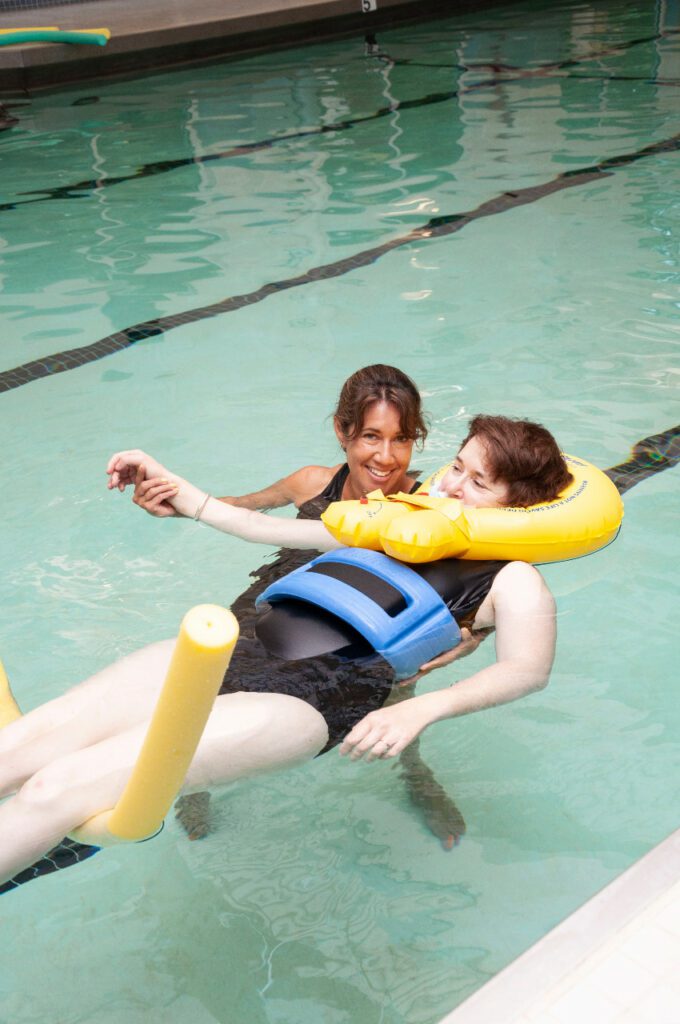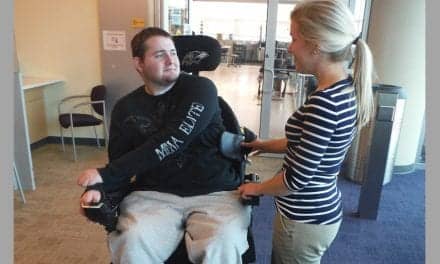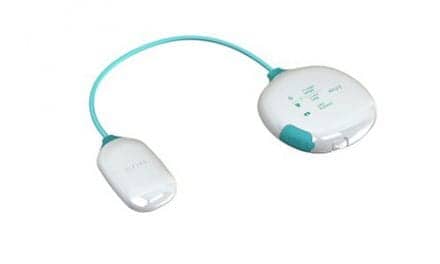PHOTO CAPTION: Ingrid Marschner, PT, Gaylord Specialty Healthcare, guides client Cathy Michelle Osborne through her aquatic therapy session. (Photos: Karen Ingham)
A deep dive into the benefits of aquatic therapy for neurorehabilitation.
by Kaila Morin, PT, DPT, CBIS
The pool is a unique healing environment that has proven to accelerate the recoveries of many neurorehabilitation clients. Aquatic therapy is quickly gaining in popularity as a highly effective adjunct or alternative to land-based therapy due to the immense inherent beneficial properties of water.
The simple addition of aquatic therapy into a patient’s plan of care may propel their progress, enabling them to stand on their own, take their first unassisted steps, climb stairs, or achieve other milestones for the first time in weeks, months—or even years!
Aquatic therapy not only fosters physical improvements in strength, balance, and functional mobility, but can greatly bolster confidence in clients’ abilities both in and out of the water. People are considerably more amenable to trying increasingly challenging activities in a pool rather than on land due to the water’s buoyancy and low fall risk.
Incorporating aquatic therapy into the plan of care for this population can also be a fun and highly motivating addition that helps clients continue to push the envelope and expedite their recoveries. This article further explores how aquatic therapy can benefit such clients.
Dipping a Toe into the Aquatic Therapy Basics
At Gaylord Specialty Healthcare, a nonprofit rehabilitation-focused healthcare system headquartered in Wallingford, Conn, physical therapists and occupational therapists perform inpatient and outpatient aquatic therapy in a large therapeutic pool to assist patients in their recoveries from neurological and medically complex conditions.
Gaylord’s aquatic center features a 75-foot by 25-foot pool that is maintained at a therapeutic temperature of 90 to 92 degrees. The pool is equipped with stairs with handrails, a mechanical pool lift chair, and a Hoyer lift to make it accessible for clients of all functional levels. It also features a submerged bench, a deep-water station for pull-ups and push-ups, and warm water jets located on the sides of the pool at all depths. The pool ranges from three feet to nine feet in depth.
Other pool equipment frequently utilized by Gaylord therapists and clients includes step benches, buoyancy cuffs and belts, hook-and-loop weights for use on wrists and ankles, webbed gloves, cervical collars, noodle floats, paddles, barbells, and dumbbells of various difficulties.
Therapists utilize the pool’s design and available specialized aquatic equipment to address many different areas of mobility including gait, balance, strengthening, endurance, pain management, tone management, muscle relaxation, and performance of functional tasks.
An aquatic physical therapist will customize and train clients in an aquatic exercise program that is appropriate for their level of mobility. In some instances, clients may participate solely in aquatic therapy until they are strong enough to progress to land-based therapy, or they may participate in a combination of land- and aquatic-based therapies simultaneously.
Clients can transition to Gaylord’s community-based aquatic program when they are discharged from therapy and are deemed safe to do so. It is very typical for a family member or caregiver to also be trained in the aquatic program so they can safely assist a client with their independent exercise program after therapy discharge.
Goal-Centered Aquatic Therapy Treatment for Neurological Conditions
Neurological conditions can affect many different aspects of a person’s life and overall mobility and can result in partial or complete paralysis of limb(s), muscle weakness, altered or loss of sensation, impaired cognitive ability, pain, increased or decreased muscle tone, impaired movement patterns, impaired coordination, impaired gait and balance, and increased fatigue or decreased endurance.
Some of the neurological conditions that would benefit from participation in aquatic therapy include—but are not limited to—stroke, traumatic brain injury, multiple sclerosis, amyotrophic lateral sclerosis, Parkinson’s disease, spinal cord injury, Guillain-Barre syndrome, cerebral palsy, and amputations.
Physical therapists aim to provide clients with ways to improve their independence in their daily lives including their functional mobility. These specialists address all different aspects of a client’s mobility including gait, balance, strength, transfers, and endurance, which can be addressed both on land and in an aquatic environment.
The rehabilitation process includes a thorough clinical evaluation, the establishment of a plan of care including client-centered goals and functional goals, and ultimately the implementation of interventions that will help a client achieve those goals.
This process also requires a collaborative relationship between the therapist and client that is focused on achieving meaningful and purposeful goals. Though the goals may be similar from client to client, the selected interventions and exercises used in treatment often vary due to individualized needs and interests. For example, it may be meaningful for one client to return to playing golf while another may want to have the ability to take walks with their grandchildren.
Pressure + Warmth + Buoyancy = Improved Outcomes
Water inherently has a number of unique and beneficial properties that can improve joint flexibility, muscle strength, balance, and gait while simultaneously decreasing pain, abnormal tone, spasticity, and rigidity.
For example, water is significantly more resistive than air, and this unique property allows for strengthening of weakened muscles. Items like ankle weights, wrist weights, dumbbells, and paddles can be used to further increase resistance. Immersion in warm water increases blood supply to help relax painful and tight muscles.

In a temperature-controlled pool, the water’s warmth, in conjunction with hands-on techniques, is effective in decreasing muscle tone, spasticity, and rigidity. Meanwhile, the hydrostatic pressure of the water places consistent pressure on the body, which can also help decrease swelling and improve circulation.
The natural buoyant property of water offers a significant advantage because it reduces the effects of gravity and allows for increased joint range of motion. A person’s affected body limb(s) will float, making it easier—and less painful—to move. Buoyancy can also lend a sense of additional comfort to clients.
In combination, pressure and buoyancy provide substantial support to a client’s body, which allows for increased time to react without the fear of getting injured. For this reason, clients often feel more comfortable challenging themselves with new exercises in the water because they have a greater sense of safety and a lessened fear of falling. This also increases a client’s confidence and can keep them motivated throughout their recovery process.
The water enables clients to perform certain physical activities that they may be unable to do on land. A client unable to stand independently or walk on land, for example, may very well be able to do so in the water.1
Exercise Methods
The pool environment allows the therapist to provide hands-on assistance to facilitate a desired movement or muscle activation while a client’s muscles are in a relaxed state. For example, a client can float on their back in the water with the assistance of noodles and buoyancy floats around their waist and neck. In this position, a therapist can utilize the Bad Ragaz Ring Method and can facilitate neck and trunk rotation and perform passive- and active-assisted movements of the upper and lower extremities.
Aquatic programs can include a variety of activities based on a client’s unique needs and mobility level. A typical warm-up for an ambulatory individual often includes forward, backward, and sideways walking to engage a variety of muscle groups. Upper and lower extremity exercises can be performed and made even more challenging by adding ankle weights for lower extremities and paddles or dumbbells for upper extremities.
Strength and cardiovascular exercises can include swimming and other exercises in deep water with the assistance of the appropriate flotation devices including noodles and buoyancy belts. Clients can also perform modified push-ups and pull-ups at a deep-water exercise station.
Excellent Tool for Promoting Neuroplasticity
As with all forms of rehabilitative therapies for neurological conditions, aquatic therapy also focuses on promoting neuroplasticity.
Neuroplasticity is the ability of the brain to form and reorganize connections in response to learning. It can be activated through repetitive stimulation, which can improve movement patterns by stimulating various neural connections in the brain. Neuroplasticity helps promote the ability to learn new things, strengthen areas where function is lost or has declined, and promotes recovery from brain injuries including stroke and traumatic brain injury.
An aquatic rehabilitation client walking in water is subject to a new challenge of moving with resistance. Walking in the water stimulates a whole new set of neural pathways in the brain compared to walking on land. A combination of aquatic therapy and land-based therapy if the client can tolerate it is ideal for this population because repetition is key. The more times a client repeats an action, the stronger the neural pathways will become, accelerating their neurological recovery.2
Getting Your Feet Wet
The main goal of aquatic physical therapy is to maximize a client’s independence with their functional mobility, which in turn can improve their quality of life. For example, a client has participated in aquatic therapy and has shown measurable progress in their gait quality, balance, strength, and endurance on functional measures during their physical therapy re-evaluation or discharge assessment. Because of these improvements, the client is now able to walk independently without an assistive device both in their home and community and on uneven terrain without the fear of tiring quickly or losing their balance. The client is now able to stand long enough in the kitchen to cook a meal, get dressed, and shower standing up without the fear of falling. The client has made meaningful and functional progress in their ability to perform their daily activities independently with increased confidence.
In conclusion, aquatic therapy can be a great adjunct or alternative to land-based rehabilitation for clients of all different functional levels. Aquatic therapy is a creative, enjoyable, and fun way to allow clients to maximize their function and reach their rehab goals in a unique environment and is an excellent tool to keep them motivated and engaged throughout their recovery process. RM
Kaila Morin, PT, DPT, CBIS, is an outpatient physical therapist for Gaylord Specialty Healthcare in Wallingford, Conn. She received her doctorate degree in physical therapy at the University of Hartford. She specializes in neurological rehabilitation and has a passion for working with patients after stroke and traumatic brain injuries. For more information, contact [email protected].
References
- Helen Hayes Hospital. 2013. The Benefits of Aquatic Therapy. Available at: https://helenhayeshospital.org/the-benefits-of-aquatic-therapy/ Accessed July 28 2022
- Aquatic therapy for cerebral palsy: Techniques and benefits. Flint Rehab. Available at: https://www.flintrehab.com/aquatic-therapy-for-cerebral-palsy/ Published June 1, 2021. Accessed July 28 2002.
Related Content:
Aquatic Therapy for Spinal Cord Injury





